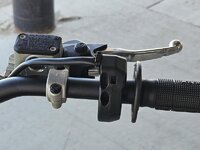- Likes
- 4,491
- Location
- Lake Havasu City, AZ
This was obvious back in ~2018 when Josh Hill battled Ricky Carmichael in Paris. Josh's bike went teeter-totter in the whoops, every single lap. I later experienced this myself. My Alta could never do the whoops well. It was much easier to jump the whoops than to skim them.What happens is the electric motor spins up the rear wheel very quickly after it leaves the ground. This raises the front and lowers the rear, causing the rear to slam into the next whoop. I have written software to mitigate this and given it to Stark Future about a year ago. I don't know if they have released it to users or plan to do so.
The reason, I think, ICE bikes skim the whoops better is because they have a bigger flywheel. So... wouldn't a dumb fix like a big enough "virtual flywheel" make electric bikes perform nearly equally?
In theory, if the controller is fast enough, and the motor is powerful enough, and the inertia of the rotating motor and wheels is large enough, then yes. In practice though, if the system runs into the limitations of any of the above, then it may not be able to sustain that whoop-skimming-wheelie. In other words: at low speeds - yes, at high speeds - not likely.what if I wanted to do the same thing without having the skills: do you think that it could be done using a kind of wheelie control which prevents the rider from raising the front end too much and flip back?

